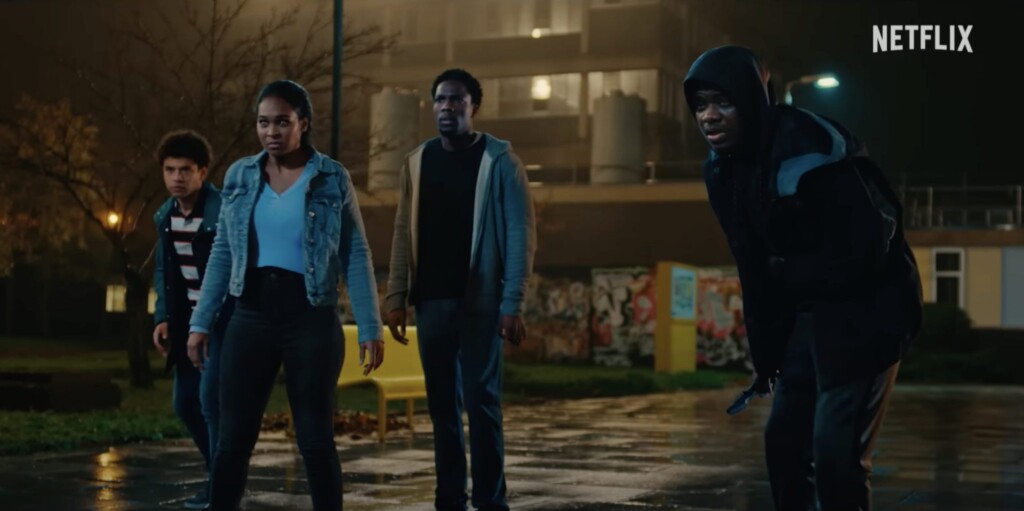Del reviews the new Netflix series ‘Supacell’

All images courtesy of Netflix.
“Supacell” Starring Tosin Cole, Nadine Mills, Eric Kofi Abrefa, Calvin Demba, Josh Teduka, Adelayo Adedayo and others. Directed by Rapman and Sebastian Thiel. Six episodes, one hour each. Rated TV-MA. Streaming on Netflix.
Plot summary: Ordinary citizens who seemingly have no connection to one another mysteriously develop superpowers. A shadowy organization wants to sequester them from humanity.
Are there spoilers in this review: No.
Del’s grade: A
Del’s take
Admit it. There have been times when you’ve wished, by the power of your mind alone, you could float the TV remote to within reach, cause the ATM to spit out an extra hundred dollars, or flatten the tires of that jerk who pulled out in front of you.
I have. Matter of fact, one time I tried to use telekinesis to make my car keys leap into my hands. Instead, people who were watching threatened to have me committed to the mental ward at the local hospital.

Alas, none of us is an X-Man – except Donald Trump, who has the power to turn people’s brains into mulch. Intellectual rot is deeply and irrevocably contagious.
But it’s nice to dream about such things and that’s the essence of “Supacell,” the new six-episode series streaming on Netflix. In “Supacell” people who inherit a mutated sickle cell gene develop a superpower, sometimes multiple superpowers, and in shades of “Firestarter” those nasty killjoys with the government are out to get them.
What sets “Supacell” apart from “The Uncanny X-Men” or other superhero stories is that the people, all black, come from ordinary walks of life, including some walks of life that are, shall we say, less than honorable. They don’t wear capes, they don’t look weird (apart from a momentary orange glow – or is that spray tan – emanating from their eyeballs), and they don’t have the usual crime-fighting truth/justice/American way agenda of, say, a Spider Man or Green Lantern.
Instead, they’re just ordinary people; well, I should say ordinary British people, going about their ordinary British lives until one day they look up and discover they can run faster than The Flash, teleport across town, or slam that bad Tinder date against a brick wall with the flick of a finger.
I wasn’t so much interested in their extranormal capabilities as I was the unfolding storyline, and here is where Rapman, the rapper and producer who is also the writer and director of “Supacell,” excels as a creator. Each character has his or her conflict trajectory and somehow – don’t ask me how – these disparate plots are woven into a single, overarching story arc with such seamless, organic dexterity that I, as a writer, am still trying to figure out how Rapman pulled it off. You thought “Stranger Things” was complicated? This is complicated. But it sure looked easy.





The actors chosen for the black roles are all excellent. There wasn’t a bad performance in the lot. With the white roles things become a bit more hackneyed. I’m not sure we need another white female villain (Sian Brooke as Victoria Kesh); Elisabeth Shue (Madelyn Stillwell on “The Boys”) and many notable others have met that quota. Ray (Eddie Marsan), who is Victoria’s immediate subordinate, comes across as the lite version of a squeaky and silly Bond bad guy.
Foul language and sex are rampant, and the story dives headlong into the seedy London drug trade, so “Supacell” is NOT a series you’d want for the kiddies. Plus, I watched it with subtitles on because I could not keep up with the accents and slang.
“Supacell” ends with a cliffhanger … and an obvious solution, which makes me think creator Rapman has something special in store, something that defies obvious. Whether he does or not, I’m definitely checking out Season 2 as I’ve got to see what happens next.
So there we are. “Supacell” won’t cure cancer or ensure world peace, but it promises six hours of good entertainment and I’m giving it a score of A.
No where did I put those car keys?
Del Stone Jr. is a former journalist and writer.

Image courtesy of Lionsgate.
“Fast Color” Starring Gugu Mbatha-Raw, Christopher Denham, Lorraine Toussaint and Sanniya Sidney. Directed by Julia Hart. 100 minutes. Rated PG-13. Hulu.
Del’s take
“Fast Color” is pitched as a superhero movie but it is unlike any superhero movie you’ve ever seen, and I would venture to say it is not a superhero movie at all but a story about three women battling forces, both seen and not, that isolate them from the world but bind them as a family.
It is also one of those quiet, semi-science fiction dramas that slip into and out of the stream of pop entertainment garbage so noiselessly that it will not be noticed unless somebody draws attention to it.
As I watched “Fast Color” I thought of Zenna Henderson’s series of books about The People, immigrant aliens who arrive at Earth after their own world is destroyed. I also thought of the Tim Robbins movie “Code 46,” which also came and went without much fanfare but was a fine, overlooked gem of a film.
In “Fast Color,” Ruth (Gugu Mbatha-Raw) is a mother on the run, pursued by Bill (Christopher Denham), a government scientist eager to exploit Ruth’s psychokinetic abilities to cause earthquakes during the seizures that wrack her body. Ruth flees to her mother Bo’s (Lorraine Toussaint) home where Ruth’s daughter Lila (Sanniya Sidney) lives. Bo is raising Lila because Ruth is broken, a poetic way of saying she’s been struggling with substance addiction and other issues. Bo and Lila also have powers – they can take things apart and put them back together. But something that’s broken? It can’t be fixed – not by their telekinetic powers, at any rate.
That theme of brokenness operates throughout “Fast Color” – in Ruth by her moral flaws, Bo by her inability to fix Ruth and even Lila for her life of concealment, something every gay man and woman on the face of the Earth already understands. The government is broken, usually the case in movies where it is made the antagonist, and even the Earth is broken with climate change rendering water a commodity so precious America’s standard of living has descended to something that resembles the Third World.
The movie also tells us that while magic cannot fix things already broken, love may find a way. As the story winds toward its resolution we see Ruth, Bo and Lila seeking their own paths to redemption, with nary a caped crusader, death ray or dollop of the-fate-of-the-universe-lies-in-their-hands bullshit thrown in for dramatic tension.
The movie unfolds at a languid pace, which I felt was sometimes too slow, and reveals its secrets along the way requiring a patient audience. Its scope is limited and simultaneously expansive as it, like “Nomadland,” is set in the parched Southwest with its infinite horizons and empty landscapes.
The best performance of the film – and many of them are good – was by Toussaint as the suffering mother/grandmother Bo. She brought a regal dignity to the role and succeeded in avoiding the clichés and tropes of the put-upon matriarch who would suffer to spare her children.
I did not like the way Hart chose to end the film as it tended to confirm some of those clichés repudiated by everything that led up to the climax – in fact, the climax seemed more of an anticlimax and could have been reworked to provide more subtextual pop.
Still, “Fast Color” will entertain for its 100 minutes and it’s a good antidote to a lot of the nonsense that passes for science fiction in cinema these days.
I would grade it at a B+.

Mladen’s take
I enjoyed “Fast Color,” though it is incorrectly billed, as Del correctly noted.
That the streaming service, producers, studio, whoever or whatever, tried to sucker me with the claim the film is a science fiction adventure doesn’t bother me too much. “Fast Color” is a good, girl relationships movie with occasional doses of a superpower on exhibit. The superpower, by the way, comes in two flavors: controllable by its practitioner or beyond control.
The three women in the film have brains with the capability to deconstruct and reconstruct objects. When our heroines explode objects into millions of sand grain pieces and return those grains to their original uniform form, the process comes with bright, streaking stripes of color.
Best as I can tell, our heroines use the word “color” in their conversations as code for their power. “She sees colors.” “I can’t see colors.” “Does anyone else beside us three see colors?”
Bo, Ruth, and Lila have to talk carefully because they recognize that there are a whole bunch of people on the rain-starved Earth of the future who would try to weaponize their telekinesis, rather than do good with it.
Also, best as I can tell, our heroines are mortal. So, they could be snubbed by the Government if deemed a threat or some Trump-loving nationalistic fascist racist patriot citing God as his source of inspiration and authorization to cancel from the world the un-godly as he defines them.
Personally, though, had I fast color, I wouldn’t be cowering from the billions of stupid people on this planet. I’d discern ways to let those reds, greens, and blues rip to achieve world peace while I worked toward enabling the power to allow me to live forever so that I could travel to edge of the universe.
I can’t recall the soundtrack for “Fast Color,” which is good and bad. Bad in the sense that the score, at least to me, failed to add to the film. Good in that the music didn’t distract the plot. I did enjoy the song about a new day coming about halfway through the film.
“Fast Color” has a pleasantly subdued dystopian feel. The world is dry as in “Mad Max: Fury Road,” but there’s no hyperviolence among warring tribes. In fact, there’s very little violence in “Fast Color.” The director conveys desperation and dearth by showing poor pickins’ on store shelves. More effective is the unceasing reminder that the water well is going dry. Water is ladled into and out of plastic containers marked with red for maximum volume, usually about half of the actual capacity of a jug. There must be no spillage. Check into a motel and you pay for the room and the water. Faucets are useless, bathing wasteful.
However, the reason I give “Fast Color” a B+ like Del is this: Though essentially a girl movie, there’s almost no romance. The lack of romance allows me to forgive the studio for lying about the film’s true genre.
Mladen Rudman is a former journalist and technical writer. Del Stone Jr. is a former journalist and author.